Expression of synaptic vesicle protein 2A in epilepsy-associated brain tumors and in the peritumoral cortex
- PMID: 20167814
- PMCID: PMC2940585
- DOI: 10.1093/neuonc/nop028
Expression of synaptic vesicle protein 2A in epilepsy-associated brain tumors and in the peritumoral cortex
Abstract
Synaptic vesicle protein 2A (SV2A) has been identified as the binding site for the antiepileptic drug levetiracetam and is thought to decrease neuronal excitability. Since knockout of SV2A in mice leads to seizures, we hypothesized that a reduction in SV2A expression promotes seizure generation in epilepsy-associated brain tumors. We compared the SV2A expression and distribution in surgically removed tumor tissue (n = 63) and peritumoral cortex (n = 31) of patients with glial and glioneuronal tumors to normal control cortex obtained at autopsy in nonbrain tumor patients (n = 6). Additionally, we compared the SV2A expression and distribution in tumor patients with epilepsy (n = 39) with SV2A expression in tumor patients without epilepsy (n = 24). Immunohistochemistry in control cortex demonstrated strong and diffuse SV2A immunoreactivity (IR) throughout all cortical layers. Similar strong SV2A IR (with the same diffuse distribution pattern) was observed in the peritumoral cortical specimens in both patients with and without epilepsy. Modest SV2A IR was observed within the tumor area. The SV2A-positive cells detected within the tumor area were mainly entrapped neurons. Oligodendrogliomas and glioneuronal tumors displayed variable SV2A neuropil staining. In ganglioglioma (GG), strong SV2A IR was present along the dysplastic neuronal cell borders and processes. In both GG and dysembryoplastic neuroepithelial tumors, SV2A IR was occasionally observed within the neuronal perikarya. We found no differences in SV2A expression in the peritumoral cortex between the patients with and without epilepsy, which suggests that the role of SV2A in epileptogenesis in patients with glial tumors is questionable. The distinct pattern of SV2A IR in glioneuronal tumors suggests a redistribution of SV2A.
Figures



Similar articles
-
Synaptic vesicle protein 2A tumoral expression predicts levetiracetam adverse events.J Neurol. 2019 Sep;266(9):2273-2276. doi: 10.1007/s00415-019-09410-0. Epub 2019 Jun 5. J Neurol. 2019. PMID: 31168673
-
Expression patterns of synaptic vesicle protein 2A in focal cortical dysplasia and TSC-cortical tubers.Epilepsia. 2009 Jun;50(6):1409-18. doi: 10.1111/j.1528-1167.2008.01955.x. Epub 2009 Feb 12. Epilepsia. 2009. PMID: 19220410
-
Overexpression of ADK in human astrocytic tumors and peritumoral tissue is related to tumor-associated epilepsy.Epilepsia. 2012 Jan;53(1):58-66. doi: 10.1111/j.1528-1167.2011.03306.x. Epub 2011 Nov 16. Epilepsia. 2012. PMID: 22092111 Free PMC article.
-
Therapeutic Role of Synaptic Vesicle Glycoprotein 2A (SV2A) in Modulating Epileptogenesis.CNS Neurol Disord Drug Targets. 2017;16(4):463-471. doi: 10.2174/1871527316666170404115027. CNS Neurol Disord Drug Targets. 2017. PMID: 28393712 Review.
-
Brivaracetam: Rationale for discovery and preclinical profile of a selective SV2A ligand for epilepsy treatment.Epilepsia. 2016 Apr;57(4):538-48. doi: 10.1111/epi.13340. Epub 2016 Feb 26. Epilepsia. 2016. PMID: 26920914 Review.
Cited by
-
Epilepsy associated tumors: Review article.World J Clin Cases. 2014 Nov 16;2(11):623-41. doi: 10.12998/wjcc.v2.i11.623. World J Clin Cases. 2014. PMID: 25405186 Free PMC article. Review.
-
The Mechanism of Anti-Epileptogenesis by Levetiracetam Treatment is Similar to the Spontaneous Recovery of Idiopathic Generalized Epilepsy during Adolescence.Psychiatry Investig. 2017 Nov;14(6):844-850. doi: 10.4306/pi.2017.14.6.844. Epub 2017 Nov 7. Psychiatry Investig. 2017. PMID: 29209390 Free PMC article.
-
Gliomas and seizures.Med Hypotheses. 2012 Nov;79(5):622-6. doi: 10.1016/j.mehy.2012.07.037. Epub 2012 Sep 5. Med Hypotheses. 2012. PMID: 22959996 Free PMC article.
-
Multi-omics technologies and molecular biomarkers in brain tumor-related epilepsy.CNS Neurosci Ther. 2024 Apr;30(4):e14717. doi: 10.1111/cns.14717. CNS Neurosci Ther. 2024. PMID: 38641945 Free PMC article. Review.
-
A Favorable Response to Levetiracetam in a Patient with Metastatic Adenoid Cystic Carcinoma.Intern Med. 2018 Mar 1;57(5):721-724. doi: 10.2169/internalmedicine.9300-17. Epub 2017 Nov 20. Intern Med. 2018. PMID: 29151513 Free PMC article.
References
-
- van Breemen MS, Wilms EB, Vecht CJ. Epilepsy in patients with brain tumours: epidemiology, mechanisms, and management. Lancet Neurol. 2007;6(5):421–430. - PubMed
-
- Aronica E, Leenstra S, van Veelen CW, et al. Glioneuronal tumors and medically intractable epilepsy: a clinical study with long-term follow-up of seizure outcome after surgery. Epilepsy Res. 2001;43(3):179–191. - PubMed
-
- Blumcke I, Wiestler OD. Gangliogliomas: an intriguing tumor entity associated with focal epilepsies. J Neuropathol Exp Neurol. 2002;61(7):575–584. - PubMed
-
- Klein M, Engelberts NH, van der Ploeg HM, et al. Epilepsy in low-grade gliomas: the impact on cognitive function and quality of life 3. Ann Neurol. 2003;54(4):514–520. - PubMed
-
- Wen PY, Marks PW. Medical management of patients with brain tumors. Curr Opin Oncol. 2002;14(3):299–307. - PubMed
Publication types
MeSH terms
Substances
LinkOut - more resources
Full Text Sources
Other Literature Sources
Medical

